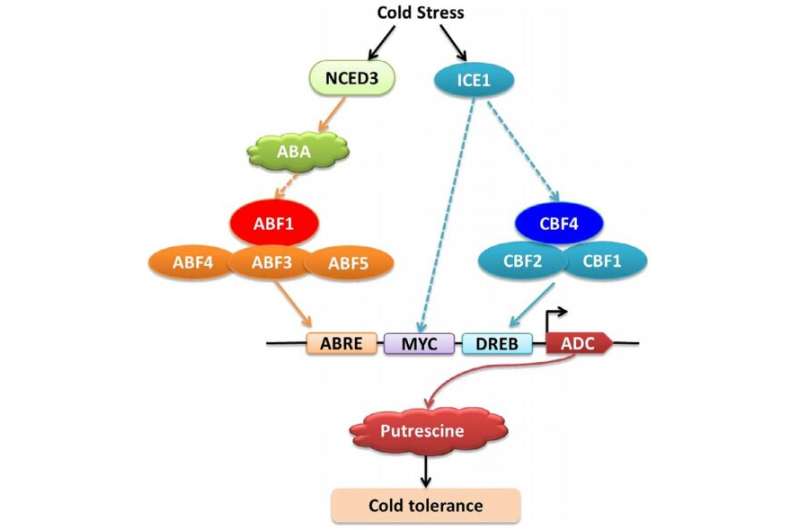How do PA, ABA, and CBF pathways synergistically regulate melon cold tolerance?

Polyamines (PAs), including putrescine (Put, a diamine), spermidine (Spd, a triamine), and spermine (Spm, a tetramine), are low-molecular-weight polycations and aliphatic nitrogen-containing substances. They play important roles in the overall life cycle of plants, from seed germination to fruit ripening, abscission, and senescence. There has been a growing interest in the study of PAs involved in plant stresses, including drought, hypoxia, high temperature, low temperature, salinity, and metal toxicity. The main role of PAs in plant stress is to counteract the damage caused by reactive oxygen species (ROS) and to prevent free radical damage or oxidative stress while also modulating ion channels to protect the morphology and integrity of cell membranes, nucleic acids, and proteins. PAs interact with hormone pathways (ethylene, jasmonate, auxin, gibberellins, cytokinins, abscisic acid [ABA], salicylic acid, and brassinosteroids) and other signaling molecules (Ca2+, NO, H2O2, and gamma-aminobutyric acid) to help plants cope with adverse environments.
Over the past two decades, there has been an emerging understanding of the crosstalk between ABA and PAs in response to environmental stress. ABA-responsive element (ABRE)-binding factors (ABFs) are core components in ABA signaling and are broadly involved in plant growth and development, as well as responses to biotic and abiotic stresses such as cold. C-repeat binding factors (CBFs) act at the crossroads of the transcriptional regulatory network that underlies cold stress response. They can bind directly to DRE/CRT (dehydration-responsive element/C repeat) cis-acting elements in the promoters of cold-regulated (COR) genes and trigger their expression to help plants withstand the bitter cold.
Melon, which originated in tropical and sub-tropical areas but is now cultivated worldwide, is vulnerable to cold damage in temperate latitudes. Evidence suggests that exogenous ABA can enhance cold tolerance of oriental melon seedlings, and PA accumulation contributes to adaptation to root-zone hypoxia stress, Ca(NO3)2 stress, and salinity-alkalinity stress in melon seedlings, as well as cold stress in melon fruit. Only two CmCBFs, CmCBF1 and CmCBF3, have been identified, and their expression is positively correlated with cold tolerance in melon fruit. However, whether the PA, ABA, and CBF pathways synergistically regulate melon cold tolerance has been largely unknown.
Recently, scientists from Shenyang Agricultural University reported that the ABA, CBF, and polyamine pathways may form a cooperative regulatory network to control plant cold stress response. In a preliminary experiment, the authors found that among the three PAs, only Put was present at significantly higher levels in a cold-tolerant genotype compared with a cold-sensitive genotype. Because arginine decarboxylase (ADC) is the key synthetase that catalyzes putrescine biosynthesis in plants, the authors then examined the expression of the ADC-encoding gene CmADC under cold treatment. As expected, low temperature induced CmADC expression, and sequence analysis showed that the CmADC promoter contained at least three ABRE and three DRE motifs. The authors isolated four CmCBFs and five CmABFs that were significantly induced in response to cold stress. CmABF1 and CmCBF4 were selected as candidate TFs that could directly bind to promoter fragments of CmADC in vitro and in planta to promote its transcription. Virus-induced gene silencing (VIGS) assays further demonstrated that CmABF1 and CmCBF4 played positive roles in the cold tolerance of melon seedlings by promoting Put synthesis. This work has been published in the journal Horticulture Research.
“Our study provides new evidence that the ABA and CBF pathways in cold response are not entirely independent and that CmADC is at the junction of these pathways,” said the researchers.
Chinese scientists reveal a novel signaling pathway for cold tolerance in rice
Meng Li et al, CmABF1 and CmCBF4 cooperatively regulate putrescine synthesis to improve cold tolerance of melon seedlings, Horticulture Research (2022). DOI: 10.1093/hr/uhac002
Provided by
Nanjing Agricultural University The Academy of Science
Citation:
How do PA, ABA, and CBF pathways synergistically regulate melon cold tolerance? (2022, August 4)
retrieved 4 August 2022
from https://phys.org/news/2022-08-pa-aba-cbf-pathways-synergistically.html
This document is subject to copyright. Apart from any fair dealing for the purpose of private study or research, no
part may be reproduced without the written permission. The content is provided for information purposes only.
For all the latest Science News Click Here
For the latest news and updates, follow us on Google News.

